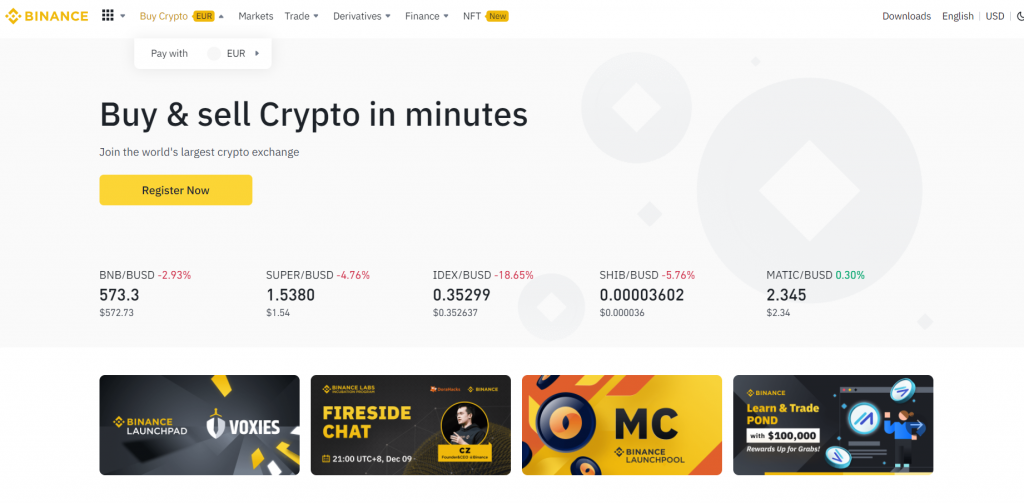
Liquidity pools are one of the wonders of the crypto age. They’re so simple a child can understand them, yet so effective they render hundreds of years of traditional trading practices redundant.
Let’s take a look at one of crypto’s most influential innovations and see what’s behind the Liquidity Pool buzzwords.
What you'll learn 👉
What is a liquidity pool?
It’s a load of crypto-assets all thrown together in one big pot. But what for? Traditional centralized exchanges need to offer a buyer or seller whenever a customer wants to make a trade. There won’t always be another trader waiting to sell the asset that they want to buy, so the market makers step in and make the trade on behalf of the exchange. Market makers hold large amounts of assets to make sure trades happen. They provide “liquidity.”
A liquidity pool is different. The large pool of assets stored in it guarantees there’s always a trade available without a person or company fulfilling the market maker role. It’s known as an AMM, Automatic Market Maker. This is a crucial innovation for decentralized (DeFi) applications, ridding them of the requirement for centralized companies or individuals to enable the market.
The market-making industry is shady at best, and it’s outright corrupt in many cases – more of which later.
Liquidity Pools vs. Order Books
So what are the advantages of LPs over traditional Order Books? Apart from the decentralization possibilities, the AMM will not cheat. There’s a lot of money to be made as a market maker, so much so that market makers pay exchanges billions of dollars for the business. Selling the trades to market makers is called Payment For Order Flow (PFOF) and was originated by the notorious Bernie Madoff in order to “front-run” other traders.
Put simply, the trade data of millions of users are used to “get in front” of the profitable trades and scalp a small profit. It’s illegal for stocks and securities markets, according to the SEC, but crypto exchanges are still unregulated so it’s not yet banned. It’s immoral, but not illegal. An AMM doesn’t do this. It follows its rules as defined when it was set up, or as voted on by the pool’s investors. It’s verifiable and transparent so you don’t need to trust the behavior of sociopathic financial engineers.

The best bit is that the profits from a liquidity pool are earned by the pool investors, not the nefarious market-making companies. Of course, the exchange takes its cut of the trading fees, but it opens up the business to regular retail investors. You no longer need to be a Wall Street insider to profit from the exchange trading market.
What’s the catch? If you manage to avoid rug-pulls, scams, and centralized faux DeFi projects, there’s still an inherent risk with the AMM liquidity pool model. The price and the proportions of the pool’s assets can fluctuate wildly, throwing off the balancing mechanism.
As a trader, this is the risk of a large trade affecting the pool’s need to rebalance. The automatic adjustment will negatively affect the price you are offered – this effect is called slippage.
As a liquidity provider, the risk is a lost opportunity cost that has been misnamed “Impermanent Loss.” More about these issues later.
How do liquidity pools work?
The most basic form of a liquidity pool has 2 assets in fixed proportions, for example, SOL and BNB. People exchange their SOL for BNB or their BNB for SOL. As long as there is enough of both assets to cover the trades, all is well. When a trade is made, the algorithm automatically adjusts the price of each asset to maintain the value ratio of the two assets in the pool.
There are variations with more than two assets in a pool, and more advanced mathematics to “smooth out” the rebalancing and reduce slippage. Some liquidity pools will automatically buy cryptocurrency on the open market to rebalance the assets, earning trading fees as they do so.
They work for the retail investor by providing a vehicle in which you can invest your tokens. You can earn a yield while your assets are busy gaining value. You’re renting your crypto out to an exchange, for which you make a profit.
How to join Binance liquidity pools?
Binance account holders are invited to invest their crypto in several types of liquidity pools. The most common is the Binance Swap Pool. Choose the pool that contains your target cryptos and click on the Liquidity button in the right-hand column. The staking window displays all we need to do to get started.
Once I selected the BUSF/ETH pool, I could choose how much to invest. Binance pools allow us to invest one or both of the cryptocurrencies in the pool, but you pay a 0.2% fee if you only invest in one of the two cryptocurrencies. Once we have selected how much of each asset we would like to stake, we can see the projected yield and our position in the pool.
You can see the current pool size and how much of each asset is in the pool. Your fees, if any, will be displayed along with the portion of the pool you own. Next, you see current slippage rates and the annualized yield, based on the last 24 hours’ price action. You agree to the T&Cs and click “Add Liquidity.”
To remove your crypto from a liquidity pool simply click “Remove” in the top left-hand corner of the staking window and follow the onscreen instructions. It’s all very intuitive and requires no prior knowledge or experience.
Different Types of Liquidity Pools
Binance features Mining Pools, locked staking, and savings programs. In each case, you can put your crypto to work to generate a yield from whatever activity is being undertaken by the pool. They all have their risks and rewards, but in general, you make the most yield from staking tokens that people most want to trade or borrow.
The highest risks come from the most volatile cryptocurrencies. The most stable yields come from stablecoins. The suggested yields are only estimates and may change radically depending on market conditions.
The Risks of Liquidity Pools
As a trader, the risks are paying over the market price for your crypto. This price slippage is caused when one of the assets in the pool is traded much more than the other. This is less of an issue in the larger pools so would not affect the average retail trader on Binance.
It only becomes a problem with the more exotic, less well-funded liquidity pools. There’s a warning about the amount of slippage whenever you make a trade, so it shouldn’t take you by surprise.
Impermanent Loss
From an investor’s point of view, things are much riskier. When you come to remove your liquidity from a pool, you may get a shock. If the underlying assets are at radically different prices compared to when you invested, you will receive fewer tokens than you staked. The total dollar value will be the same, and the claim is that you have not lost overall.
What you have lost is the opportunity to make gains on the assets you staked. That loss feels pretty permanent to me! I think the name “Impermanent Loss” is misleading, especially to those of us who do not denominate their wealth in US dollars.
Closing Thoughts
Simple, but brilliant – the AMA concept has enabled a whole field of research and innovation in finance. It’s a disruptive technology that upholds the ideology of decentralized finance. It’s transparent, fair, honest, and incorruptible when it’s done right. Liquidity pools democratize the lucrative exchange trading business.
Of course, there are the scammers, as Mark Cuban found to his cost when he staked a pile of crypto in Titan on Iron Finance. There are also pools that claim to be decentralized but are in reality administered by a particular company. Although not decentralized, Binance is a name you can trust, so if you want to stake in a safe liquidity pool, they’re one of the best options. Again, be aware that your transactions are all recorded and made available to the IRS and law enforcement.
Please read some of the articles we wrote related to Binance:
- Binance Staking Review
- 3 Steps to Calculate Binance Taxes
- Binance Options vs Futures: What are the differences and similarities?
- How To Create & Trade NFTs on Binance
- Binance Margin vs Futures: What is The Difference?
- Binance Cross vs Isolated Margin – What is The Difference?
- Binance Wallet Review – Is It Safe & How To Get It?
- What is Binance Dual Investment? How Does It Work?
- How to Short on Binance Futures? Shorting Crypto on Binance – Full Guide
- Binance Marketplace Review – What Can You Buy on Binance Marketplace?
- How To Stake ETH 2.0 on Binance? Is It Safe & Worth It?
- What is Binance Launchpad? – Dive Into Coins, Rules and ROI of Binance ICO Platform
- Binance Grid Trading Review – Fees, Strategies, Profitability
- Binance Lite vs Binance Professional – Which One To Use?
- Binance P2P Review – Fees, Supported Countries, Payment Methods Overview
- Binance Earn Review – How Do Binance Fixed & Flexible Savings Work?
- Binance Gift Card Review – How To Use Binance Gift Card?
- Best Binance Bots – These Are Top Trading Bots For Binance
- Binance Liquid Swap Explained – What Are The Risks? Is It Safe?







